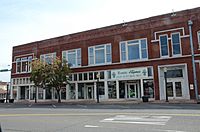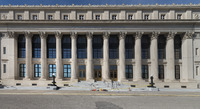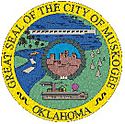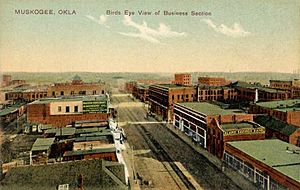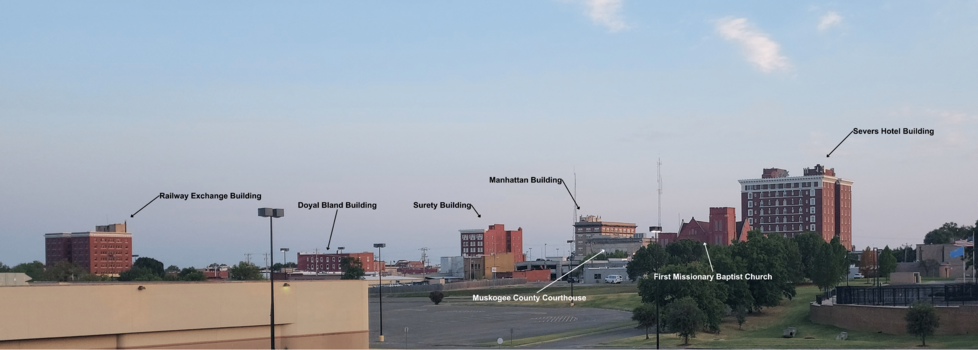Muskogee, Oklahoma facts for kids
Quick facts for kids
Muskogee, Oklahoma
|
||
|---|---|---|
|
From top, left to right: Pre-Statehood Commercial District, Severs Hotel, Surety Building, Ed Edmondson United States Courthouse
|
||
|
||
| Etymology: Creek language | ||
| Nickname(s):
The Skoge, Oklahoma's River City, Oklahoma's Music City
|
||
| Motto(s):
"A Place Where Even Squares Can Have A Ball"
|
||
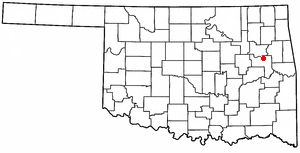
Location of Muskogee in Oklahoma
|
||
| Country | United States | |
| State | Oklahoma | |
| County | Muskogee County | |
| Founded | March 16, 1898 | |
| Government | ||
| • Type | Council-manager | |
| Area | ||
| • Total | 44.48 sq mi (115.21 km2) | |
| • Land | 42.96 sq mi (111.27 km2) | |
| • Water | 1.52 sq mi (3.94 km2) | |
| Elevation | 577 ft (176 m) | |
| Population
(2020)
|
||
| • Total | 36,878 | |
| • Density | 858.43/sq mi (331.44/km2) | |
| Time zone | UTC−6 (CT) | |
| • Summer (DST) | UTC−5 (CT) | |
| ZIP Codes |
74401-74403
|
|
| Area code(s) | 918 | |
| FIPS code | 40-50050 | |
| GNIS feature ID | 2411201 | |
| Website | muskogeeonline.org | |
Muskogee (/məˈskoʊɡiː/) is a city in Oklahoma, United States. It is the 13th-largest city in the state. Muskogee is also the main city of Muskogee County.
The city is home to Bacone College. It is about 48 miles southeast of Tulsa. In 2020, about 36,878 people lived in Muskogee.
Contents
History of Muskogee
French fur traders might have set up a temporary camp near Muskogee in 1806. The first lasting European-American settlement started in 1817. It was on the south bank of the Verdigris River.
After 1830, the Muscogee Creek people were forced to move here. This happened because of the Indian Removal Act. They were one of the "Five Civilized Tribes" moved from the American Southeast to Indian Territory. They brought their slaves with them.
An important building called the Indian Agency was built in Muskogee. It was a two-story stone building. Leaders from the Five Civilized Tribes met there. Today, it is a museum. It is located on Agency Hill inside Honor Heights Park.
In 1872, the Missouri–Kansas–Texas Railroad reached the area. A federal court opened in Muskogee in 1889. Around this time, new settlers could claim land in Indian Territory. The city officially became a city on March 19, 1898.
Charles N. Haskell moved to Muskogee in 1901. He helped the city grow a lot. By 1910, Muskogee had over 25,000 people. Haskell built many buildings and helped create railroads. These railroads connected Muskogee to other places. This helped the city's businesses and brought more people.
Muskogee became more important as it grew. Before Oklahoma became a state, the Five Civilized Tribes tried to form their own state. They met in Muskogee on August 21, 1905. They wanted to create the State of Sequoyah, led by Native Americans. They planned for Muskogee to be its capital. However, US President Theodore Roosevelt did not approve this idea. Oklahoma became a state on November 16, 1907.
Muskogee was also a hub for several railroads. These included the Midland Valley Railroad. The city was also on the Jefferson Highway, a long road built in 1915. This road stretched over 2,300 miles from Canada to Louisiana.
In 2008, Muskogee gained attention when John Tyler Hammons was elected mayor. He was only 19 years old. This made him one of the youngest mayors in American history.
Muskogee's Geography
Muskogee covers about 38.8 square miles. Most of this is land, and a small part is water. The city is close to where three rivers meet: the Arkansas River, Verdigris River, and Grand River. This area is often called Three Rivers.
Muskogee is in the Arkansas River Valley. It is lower in elevation than many other parts of Oklahoma. The city is where the oak and hickory forests meet the prairie lands. It is also a nearby community to Tulsa.
The weather in Muskogee is usually warmer and more humid than in other parts of Oklahoma.
Climate and Weather
Muskogee has a humid subtropical climate. This means it has hot, humid summers and mild winters. The hottest temperature ever recorded was 118°F (48°C) in August 1936. The coldest was -14°F (-26°C) in February 1905.
| Climate data for Muskogee, Oklahoma, 1991–2020 normals, extremes 1905–present | |||||||||||||
|---|---|---|---|---|---|---|---|---|---|---|---|---|---|
| Month | Jan | Feb | Mar | Apr | May | Jun | Jul | Aug | Sep | Oct | Nov | Dec | Year |
| Record high °F (°C) | 81 (27) |
90 (32) |
93 (34) |
97 (36) |
98 (37) |
108 (42) |
114 (46) |
118 (48) |
109 (43) |
98 (37) |
88 (31) |
81 (27) |
118 (48) |
| Mean maximum °F (°C) | 69.6 (20.9) |
74.2 (23.4) |
81.5 (27.5) |
85.7 (29.8) |
90.4 (32.4) |
94.5 (34.7) |
101.4 (38.6) |
102.1 (38.9) |
95.7 (35.4) |
87.8 (31.0) |
78.3 (25.7) |
69.8 (21.0) |
103.3 (39.6) |
| Mean daily maximum °F (°C) | 49.2 (9.6) |
54.1 (12.3) |
63.2 (17.3) |
71.9 (22.2) |
79.3 (26.3) |
87.7 (30.9) |
93.0 (33.9) |
92.8 (33.8) |
84.8 (29.3) |
74.0 (23.3) |
61.7 (16.5) |
51.5 (10.8) |
71.9 (22.2) |
| Daily mean °F (°C) | 37.5 (3.1) |
41.9 (5.5) |
51.2 (10.7) |
59.9 (15.5) |
69.0 (20.6) |
77.5 (25.3) |
82.3 (27.9) |
81.2 (27.3) |
73.2 (22.9) |
61.5 (16.4) |
49.8 (9.9) |
40.6 (4.8) |
60.5 (15.8) |
| Mean daily minimum °F (°C) | 25.8 (−3.4) |
29.7 (−1.3) |
39.2 (4.0) |
47.9 (8.8) |
58.7 (14.8) |
67.2 (19.6) |
71.2 (21.8) |
69.7 (20.9) |
61.6 (16.4) |
49.1 (9.5) |
37.9 (3.3) |
29.6 (−1.3) |
49.0 (9.4) |
| Mean minimum °F (°C) | 12.5 (−10.8) |
13.6 (−10.2) |
21.3 (−5.9) |
31.5 (−0.3) |
40.9 (4.9) |
55.5 (13.1) |
62.0 (16.7) |
60.1 (15.6) |
46.6 (8.1) |
33.3 (0.7) |
21.2 (−6.0) |
14.2 (−9.9) |
8.1 (−13.3) |
| Record low °F (°C) | −11 (−24) |
−14 (−26) |
−2 (−19) |
21 (−6) |
31 (−1) |
47 (8) |
49 (9) |
48 (9) |
34 (1) |
16 (−9) |
10 (−12) |
−7 (−22) |
−14 (−26) |
| Average precipitation inches (mm) | 1.94 (49) |
2.36 (60) |
3.09 (78) |
4.88 (124) |
5.25 (133) |
5.00 (127) |
3.32 (84) |
3.14 (80) |
4.31 (109) |
4.07 (103) |
3.23 (82) |
2.56 (65) |
43.15 (1,094) |
| Average snowfall inches (cm) | 0.9 (2.3) |
0.3 (0.76) |
0.5 (1.3) |
0.0 (0.0) |
0.0 (0.0) |
0.0 (0.0) |
0.0 (0.0) |
0.0 (0.0) |
0.0 (0.0) |
0.0 (0.0) |
0.0 (0.0) |
0.9 (2.3) |
2.6 (6.66) |
| Average precipitation days (≥ 0.01 in) | 6.4 | 6.1 | 8.1 | 8.3 | 11.0 | 8.4 | 6.0 | 5.8 | 8.3 | 7.3 | 7.5 | 6.5 | 89.7 |
| Average snowy days (≥ 0.1 in) | 0.3 | 0.3 | 0.3 | 0.0 | 0.0 | 0.0 | 0.0 | 0.0 | 0.0 | 0.0 | 0.0 | 0.4 | 1.3 |
| Source 1: NOAA | |||||||||||||
| Source 2: National Weather Service | |||||||||||||
Flooding in Muskogee
Muskogee can experience floods. In May 2019, the Arkansas River rose over 42 feet. This was the highest level since 1943. A submarine, the U.S.S. Batfish, broke free from its dock. Two barges also broke loose. People in Webber Falls had to leave their homes.
Muskogee's Population
| Historical population | |||
|---|---|---|---|
| Census | Pop. | %± | |
| 1900 | 4,254 | — | |
| 1910 | 25,278 | 494.2% | |
| 1920 | 30,277 | 19.8% | |
| 1930 | 32,026 | 5.8% | |
| 1940 | 32,332 | 1.0% | |
| 1950 | 37,289 | 15.3% | |
| 1960 | 38,059 | 2.1% | |
| 1970 | 37,331 | −1.9% | |
| 1980 | 40,011 | 7.2% | |
| 1990 | 37,708 | −5.8% | |
| 2000 | 38,310 | 1.6% | |
| 2010 | 39,223 | 2.4% | |
| 2020 | 36,878 | −6.0% | |
| Sources: | |||
In 2000, there were 38,310 people living in Muskogee. There were 15,523 households. About 29.3% of households had children under 18. The average household had 2.39 people.
The population was spread out by age. About 25.7% were under 18. About 17.4% were 65 or older. The average age was 37 years old.
Getting Around Muskogee
Several major roads pass through Muskogee. These include U.S. Route 62, U.S. Route 64, and U.S. Route 69.
The Muskogee-Davis Regional Airport is five miles south of downtown. It has a long runway for different types of planes. For bigger flights, people can go to Tulsa International Airport. This airport is about 49 miles away.
Muskogee also has the Port of Muskogee. This port is on the McClellan–Kerr Arkansas River Navigation System. It allows boats to travel to and from the Gulf of Mexico.
Muskogee's Economy
Muskogee is an important business center for eastern Oklahoma. Many industries are located here. Georgia-Pacific has a large factory in Muskogee. They make tissue, paper towels, and napkins. This factory is Muskogee's biggest employer, with 800 workers.
Arts and Fun in Muskogee
Muskogee is home to Honor Heights Park. This park is a memorial for World War I. It has many azalea flowers and hosts an annual Azalea Festival in April. In winter, the park turns into the Garden of Lights. This is a huge Christmas lights display.
Muskogee has six museums. The Five Civilized Tribes Museum shows the art and culture of the Five Civilized Tribes. The U.S.S. Batfish and War Memorial Park features a submarine. The Three Rivers Museum tells the history of the area and its railroads. The Oklahoma Music Hall of Fame celebrates Oklahoma musicians.
The Thomas-Foreman Historic Home is an old farmhouse from 1898. It shows how people lived long ago. The Ataloa Lodge is on the Bacone College campus.
Muskogee is also home to The Castle of Muskogee. This castle hosts many events. These include a Halloween festival called 'Haunted Castle'. They also have a Christmas Kingdom and the Oklahoma Renaissance Festival. The Renaissance festival started in 1995. It brings in many visitors each year for jousting, dancing, and other fun events.
The Muskogee Little Theatre (MLT) is a local theater group. It started in 1972. They put on many shows each year. These include plays for young people and older adults. The theater also offers classes and workshops.
The local newspaper, the Muskogee Phoenix, started in 1888. It is still published today.
Education in Muskogee
Most of Muskogee is served by Muskogee Public Schools. Some parts are covered by Hilldale Public Schools and Fort Gibson Public Schools. Muskogee also has the Oklahoma School for the Blind. This school helps students in Oklahoma who are blind or have low vision.
Muskogee has four colleges and technical schools. These include Northeastern State University and Connors State College. There is also the Indian Capital Technology Center. Bacone College is a private college and the oldest college in Oklahoma.
In 2004, a student named Nashala Hearn sued the Muskogee Public School District. She was told to remove her hijab because of the school's dress code. The court decided that students could wear religious clothing if it conflicts with the dress code.
Places to Visit in Muskogee
- Arrowhead Mall
- Ataloa Lodge Museum
- Azalea Festival
- The Castle of Muskogee
- Civic Center
- Civitan Park
- Douglas Maxey Park
- Farmers market
- Five Civilized Tribes Museum
- Founders' Place Historical District
- Grant Foreman House
- Honor Heights Park
- Katy District (South Main Street)
- Muskogee Little Theatre
- Muskogee Public Library
- Oklahoma Movie Hall of Fame / Roxy Theater
- Oklahoma Music Hall of Fame
- Port of Muskogee
- River Country Family Water Park
- Three Forks Harbor
- Three Rivers Museum
- Thunderbird Speedway
- Spaulding Park
- USS Batfish (SS-310)
Sports in Muskogee
Muskogee had minor league baseball teams from 1905 to 1957. These teams had different names over the years. Some names were the Muskogee Reds, Indians, and Giants.
Three players who later joined the Baseball Hall of Fame played in Muskogee. These were Bill Dickey, Bobby Wallace, and Rube Marquard.
Muskogee teams played at different fields. These included Traction Park and Owen Field. In 1923, Babe Ruth played an exhibition game at Owen Field. Later, Mickey Mantle also played there in 1950. Today, the Muskogee Civic Center stands where Owen Field used to be.
The Muskogee Country Club hosted the 1970 U.S. Women's Open golf tournament. Donna Caponi won the event.
Meteorite Fall of 2023
On January 20, 2023, a bright fireball lit up the sky over Eastern Oklahoma. This happened at 3:38 AM. Many people in nearby cities heard a loud boom. The shockwave from the meteor shook houses.
Videos of the event were shared online. The meteor broke apart in the sky. Many small pieces, called meteorites, fell to the ground. People who hunt for meteorites came to the Muskogee area to find them.
Famous People from Muskogee
- Reubin Askew, former Governor of Florida
- Louis W. Ballard, a famous composer
- Aaron Bell, jazz musician
- Archie Bradley, baseball pitcher
- Don Byas, jazz musician
- Kristin Cast, writer
- PC Cast, writer
- Tom Coburn, former U.S. Senator
- Ernest E. Evans, a hero from World War II
- Carolyn T. Foreman, a historian
- John Tyler Hammons, one of the youngest mayors in U.S. history
- Charles N. Haskell, the first Governor of Oklahoma
- Olivia Hooker, a psychologist and educator
- James Jabara, the first American jet ace pilot
- Barney Kessel, jazz guitarist
- Leo Kottke, acoustic guitarist
- Roberta McCain, mother of Senator John McCain
- Jay McShann, jazz musician
- Robert Reed, actor who played Mike Brady on The Brady Bunch
- Bass Reeves, one of the first African-American Deputy U.S. Marshals
- Alice Mary Robertson, one of the first women in U.S. Congress
- Pee Wee Russell, jazz musician
- The Swon Brothers, music duo from The Voice
- Carrie Underwood, country music singer
- Sarah Vowell, author
- W. Richard West Jr., director of the National Museum of the American Indian
- Claude "Fiddler" Williams, jazz musician
See also
 In Spanish: Muskogee (Oklahoma) para niños
In Spanish: Muskogee (Oklahoma) para niños


